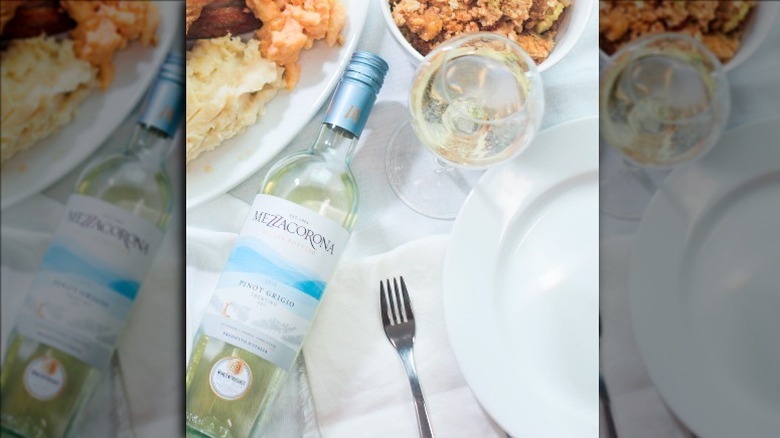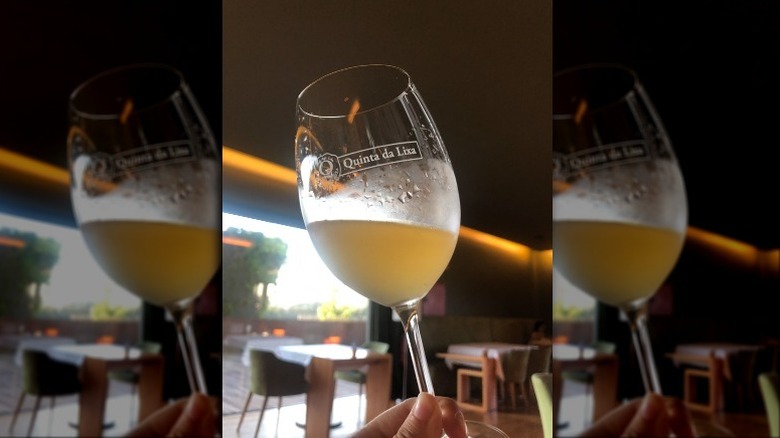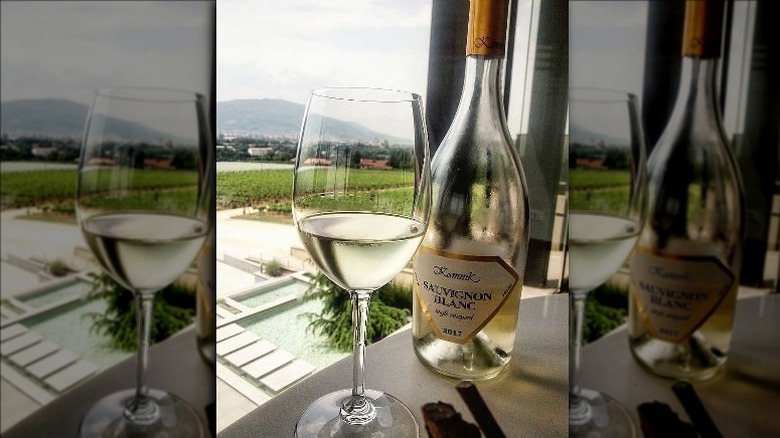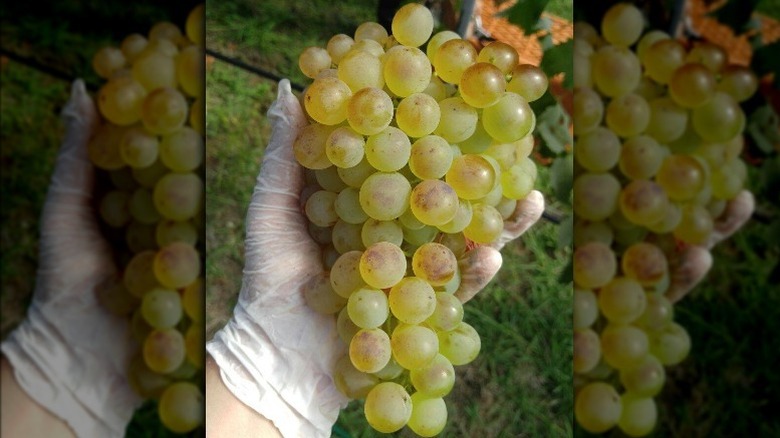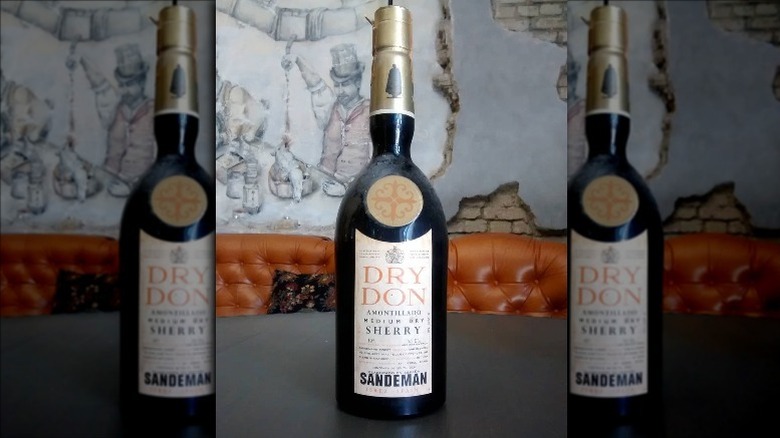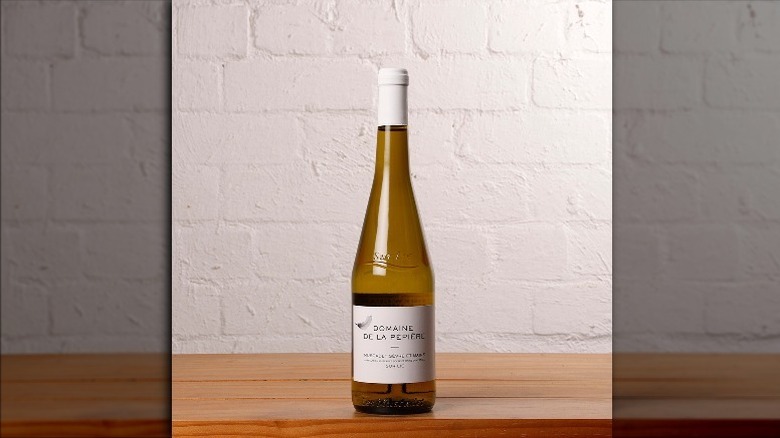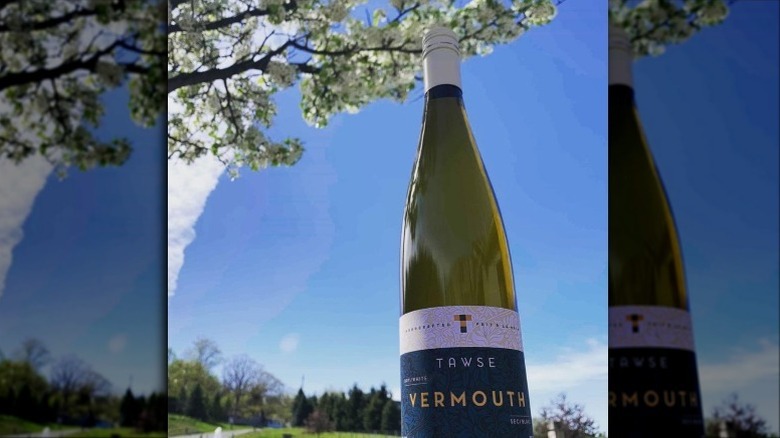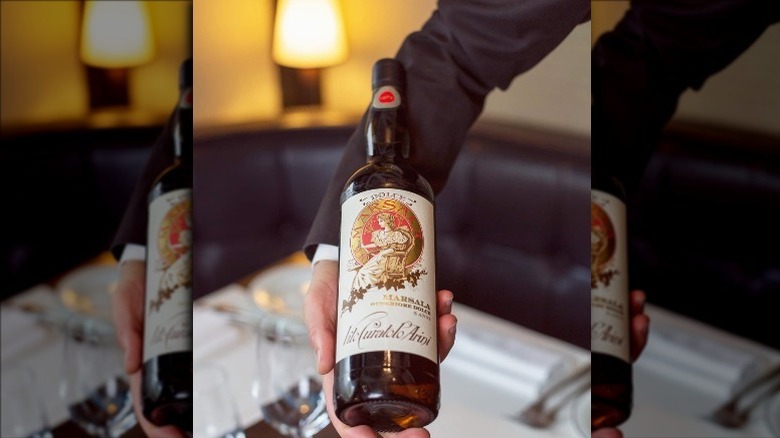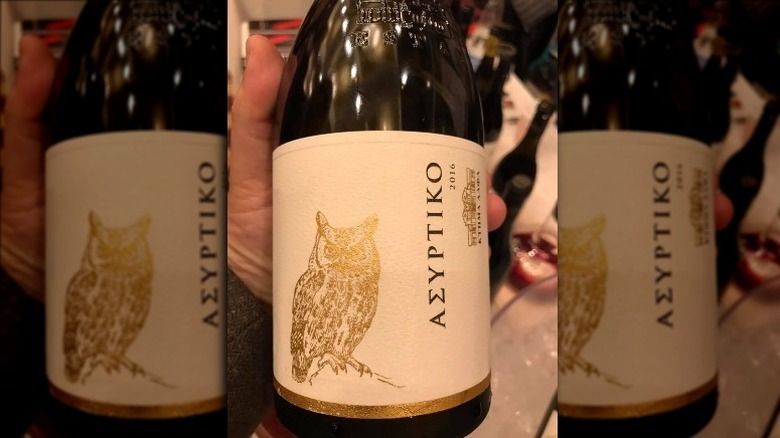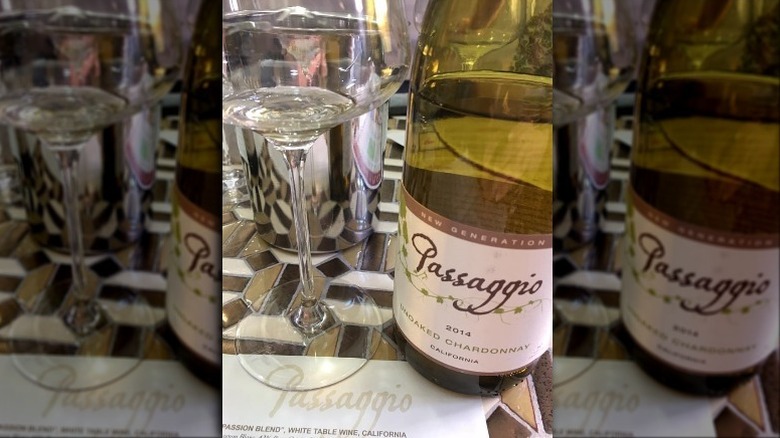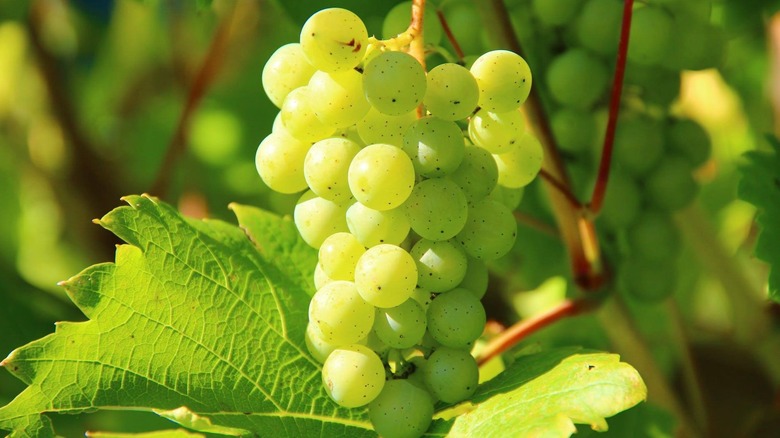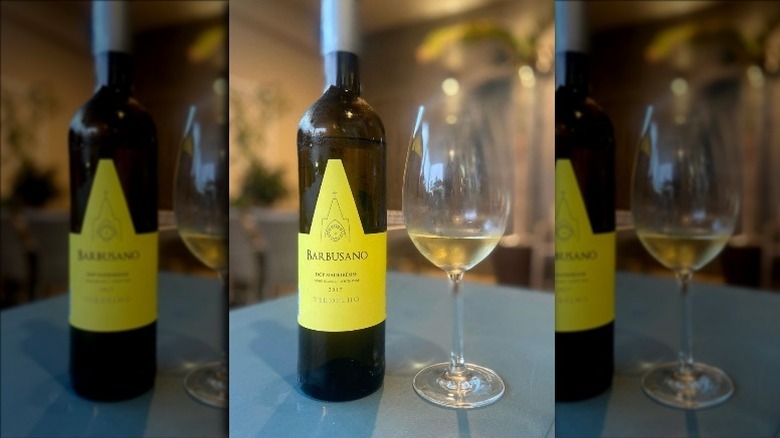13 Best White Wines For Cooking
We all love having a glass of wine while eating (and cooking) dinner, but how often are you actually incorporating wine into your dishes? Wine is frequently added to sauces, and it can be incorporated into a ton of different recipes. Sometimes, it adds acidity. Other times, it adds a hint of flavor. And all of the time, it's acceptable to take a swig from the bottle before you empty it into your pan. But while you might know just the right kind of red wine to use in a dish, you may not be as knowledgeable about the types of white wine that are most appropriate for cooking.
That's why we've done the work for you and composed a list of some of the best white wines for cooking. Now, keep in mind that not every type of wine in this list is going to go well with every dish. It's all about knowing what kind of flavors you're getting from the wine and thinking about how that's going to pair with your food. Another good pointer to keep in mind is not to spend the big bucks on a bottle of wine you're just going to cook with — though the wine should still be delicious enough to drink, of course.
Let's take a look at some of the best white wines for cooking.
1. Pinot Grigio
One of the most commonly used white wines in cooking is Pinot Grigio, and luckily for you, this is also an incredibly easy wine to find. You're likely to find quite a variety of it at your local grocery store, for that matter. Pinot Grigio is a great variety to opt for because it provides plenty of acidities, which is the quality that makes your mouth water when you get a whiff of your food. A Pinot Grigio with a moderate alcohol content, which is generally between 10% and 13% alcohol, according to Delish, is ideal. (Wines with a higher alcohol content can take longer to reduce.)
What sets Pinot Grigio apart from other crisp white wines is the fact that it's so versatile. Therefore, you don't need to know a lot about wine to pick a Pinot Grigio that's going to go well in a large portion of the dishes you make that call for white wine. It's easy, it's versatile, it's accessible ... what more could you want? We like to keep a bottle or two stocked in the kitchen that we set aside just for cooking.
2. Vinho Verde
If you're looking for a white wine that adds some zing and citrus to the dish you're cooking, then there's no need to look any further than Vinho Verde. While it may not be the most common wine you'll find at your local grocery store, you generally won't need to make a special trip to a wine shop to find a bottle of this stuff. It's a Portuguese wine, and Wide Open Eats describes it as "the Sprite of the wine world." We have to agree. It's lovely, light, and features notes of citrus. Vinho Verde is also an effervescent wine (though it misses the mark of qualifying as a semi sparkling wine, according to Serious Eats), which means it's slightly bubbly.
Wondering what Vinho Verde is best for when it comes to cooking? Wide Open Eats suggests using it to cook a chicken or turkey breast — cover the meat in some Vinho Verde, and get cooking. It's likely to enhance the flavors of otherwise somewhat neutral white meats.
3. Sauvignon Blanc
Sauvignon Blanc is all about acidity, so if you're looking for an ingredient to replace lemon or vinegar in a dish, then this wine has got you covered. Also an incredibly common varietal, you're likely to find a variety of Sauvignon Blancs at most stores that carry alcohol. It's an incredibly popular wine, and it's known for having somewhat of a "green" taste, according to Wine Folly. It also tends to be relatively dry.
The Kitchn lauds its "racy acidity" and notes that it works especially well with seafood dishes. If you're cooking mussels, clams, or other bivalves wherein a wine-centric sauce is essential to the dish, you're going to find that this wine works especially well. Additionally, it's wonderful in dishes that involve a lot of heavy creams. That's because heavy cream is dense and rich, and the acidity from the Sauvignon Blanc can help balance the flavor. Plus, since this is such a well-loved wine, it doesn't hurt to save the extra and pair it with dinner.
4. Vermentino
Never heard of Vermentino before? You're not alone. Vermentino is an Italian wine, largely produced in Sardinia, but it can be difficult to find if you're not at a specialty wine shop. According to Wide Open Eats, it's typically used in the Feast of the Seven Fishes, an Italian Christmas Eve dinner that involves a plethora of different fish dishes (via Eataly). Therefore — you guessed it — Vermentino works very well for cooking with seafood. This is due to the wine's acidity, which has a distinctive flavor of lime.
It's excellent for a few different cooking methods. First of all, we love it for poaching. Poaching is a simple and healthy way to prepare fish, and using Vermentino wine in the process makes it even more flavorful. If poaching isn't your thing, though, then you can also use Vermentino for steaming your seafood as well. It's a less intense way to infuse your food with the flavor of this wine. If you're looking for something a little different and out of the ordinary, then this is a fantastic variety of wine to experiment with in the kitchen.
5. Dry sherry
Sherry may not be the most popular type of wine on the table, but in recent years, it has become more and more noticeable on restaurant menus. And while many people think of this fortified wine as a dessert wine, that doesn't tell the whole story: While some sherries are very sweet and are preferable for pairing with dessert, others are much drier. These drier sherries are excellent to use in the kitchen for a variety of purposes.
The Kitchn claims that sherry is great because it's so versatile — you can use it in so many different ways. Adding just a small splash of it to a nearly finished dish can add a different dimension of flavor and a touch of acidity. It's also ideal for deglazing, and it can be used well in a cream sauce. Of course, it's great for drinking too: It's an ideal drink to start with if you're serving appetizers.
Sherry is funky, fun, and a little different, so we encourage using it in dishes or sipping it at will. Try it once, and you may just add a whole new tool to your cooking arsenal.
6. Muscadet
Here's another one if you might not have much experience with if you're not already into wines: Muscadet. And while Eater says the average bottle of this stuff may cost more than some of the other, more common wines you'll find on this list, you can still find somewhat affordable bottles if you know where to look. Muscadet is known as a wine that works as an excellent pairing with oysters, but it can also be employed as an essential ingredient in your cooking. Wine Folly notes flavors of sea snail, lemon, lime, and green apple — and yes, we want to take a sip already.
Wide Open Eats says that Muscadet works extremely well with other types of seafood, even beyond oysters. And if you want to make a really special dish, you can always attempt to use Muscadet to make drunken mussels. They're especially easy to make, and the flavor of this wine will do an excellent job complementing the brininess of the seafood.
7. Dry vermouth
Don't tend to drink too much? Then you may be hesitant to buy a bottle of wine just to use it in your cooking. It's especially frustrating when a recipe calls for just a cup of wine, and you're left with the rest of a bottle you know you're not going to finish in time. If this happens to you on a regular basis, do we have the wine for you: dry vermouth. You may know vermouth as the staple ingredient of a classic martini, but it can be used in so many different ways, including in your favorite recipes. Escoffier says that it works well with seafood, but you could also use it in chicken or pork dishes.
And the best part? According to Cook's Illustrated, you can keep a bottle of opened vermouth in your refrigerator for months on end. So, even if you're not planning on using wine in another dish for a few weeks, you can still keep this stuff around. However, note that as a fortified wine, vermouth has a stronger alcohol flavor than most wines, so you may want to use less of it than you would another type of white wine.
8. Marsala
If you know about any wines for cooking, then you probably know all about Marsala. It's one of the most popular types of white wine that you'll find in recipes. You know chicken Marsala? Yeah, it's because they use this type of wine to cook it. According to Usual Wines, Marsala comes from Sicily, an Italian island known for its delicious food and wine. Of course, it's ideal for making chicken Marsala if that's what you're into, but it can also be used in a variety of cream-based dishes. Again, the acidity here is a big part of what makes it desirable for cooking.
One thing to remember, though: You're going to want to find a drier Marsala. Generally, sweeter white wines don't work particularly well in recipes. Therefore, you should check the label for the word "secco": This means "dry," and it indicates that you're not going to get too much of a sugar-y taste in your dish. And if you're interested in cooking with Marsala but can't find it at the wine shop you frequent, you can always look for Madeira instead, as it's somewhat similar in flavor.
9. Sparkling wines
Have any leftover sparkling wine around the house? This can seem like a major predicament since you're not going to be able to keep the leftovers for very long. If you can't finish the bottle off by simply drinking it, you may find that it works well in a dish you plan on making soon. While sparkling wine may not seem like the first type of wine that comes to mind when you're cooking, it can actually be used in a ton of different dishes that call for white wine. However, you should keep in mind that different types of sparkling wine can vary quite a bite, so it pays to think about the type you're using before you pour it into a random sauce.
For example, Chowhound points out that champagne can be added to fresh seafood dishes and can play an important role in soups, largely because of its "biscuity" flavor. However, if you have some leftover prosecco, which tends to be on the fruitier side, you may be better off adding it to a dessert or even with a fruit-forward pork dish. A good rule of thumb? Use sparkling wines in recipes that you'd pair it with anyway.
10. Assyrtiko
When it comes to cooking with white wine, you're often looking for a dry, somewhat neutral flavor with some acidity to it. However, if you're the kind of person who doesn't like to play by the rules or wants to opt for something a little more interesting and a little less expected, then you may want to pick up a bottle of Assyrtiko. This Greek wine isn't one of the most popular varieties in the U.S., but you should be able to find it at specialty wine shops with a good selection of Greek wines.
Like many white wines, Assyrtiko plays well with seafood. A.J. Ojeda-Pons, sommelier at Temperance Wine Bar in New York City, told Real Simple that he prefers "to use a more mineral, bolder wine" when he's steaming bivalves. He says that "stainless steel-aged Assyrtiko or Assyrtiko and Athiri blends from the island of Santorini in Greece ... add an extra layer of body to the broth and enhance the briny, sea flavor of the dish with a bright, citrusy note." If you're feeling adventurous, Assyrtiko is definitely worth a try!
11. Unoaked chardonnay
You're not going to see many recipes calling for Chardonnay specifically, and that's because Chardonnay that's been aged in oak barrels often has an intense oaky flavor that just doesn't pair well with most foods. However, that doesn't mean that you have to forget about this wine varietal completely. These days, you can find plenty of Chardonnays that have been aged in steel barrels instead, and they won't add a bitter flavor to your dish.
If you're wondering what to make with the leftover Chardonnay you have on hand, you may want to take some tips from Real Simple. They say that since Chardonnay is "smooth and buttery," it can work well in all types of rich dishes. For example, they suggest heavier dishes involving butter, chicken, mushrooms, and cream. We think that a splash of Chardonnay would work especially well in a risotto dish, if you're into that kind of thing.
12. White Bordeaux
When you hear the word "Bordeaux," you probably think of red wine. But did you know that there are white Bordeauxs too? And while they may not be the most commonly used type of wine in cooking, they can complement your meal quite well if you know what you're looking for. That's because, according to Wide Open Eats, white Bordeaux is made using three types of grapes, one of them being Sauvignon Blanc, which we already know is an excellent cooking wine. The other two grapes are Semillon and Muscadelle. Since Muscadelle tends to be on the sweeter side, you're going to get a slightly different flavor than you would if you were to stick to the drier stuff.
However, Muscadelle isn't used as often as the other two grapes, if you get an inexpensive white Bordeaux, it's likely to be quite similar to a Sauvignon Blanc — it might be just a bit smoother because of the Semillon in there. Therefore, you may not want to go out of your way to find this type of wine specifically (unless your recipe calls for it), but if you have some extra lying around, don't be afraid to cook with it.
13. Madeira
You may have noticed that there are a few different types of fortified wine on this list, and Madeira is another one of them. While Madeira may not be the most commonly used wine to cook with, we think it can go well with a variety of dishes. Fine Cooking agrees with us. They say that this type of wine is ideal for deglazing a pan, especially if you're cooking meat in it. Try it with the next pork, chicken, or turkey dish you make, and you may just find that it enhances the flavor of the meat you're cooking.
However, there's one thing to keep in mind. There are different types of Madeira, and you want to make sure you're getting the right kind. Sweeter Madeiras aren't going to taste great in most dishes — they're better for drinking on their own. Instead, you should search for sercial Madeira, which is the driest type out there. Check the label before you purchase to make sure you're getting the right thing.

